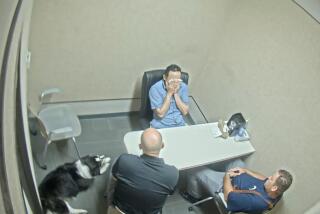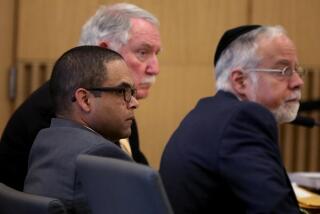Peyer Case Goes to Jury : Knott’s Outburst Led to Killing, Court Told
Cara Knott “exploded” when former CHP Officer Craig Peyer detained her in a darkened, isolated freeway off-ramp and reacted by scratching his face in a defensive move that drove Peyer to kill the San Diego State University student, a prosecutor said Tuesday during closing statements in Peyer’s murder trial.
“The longer she stayed there, the more anxious she became . . . . She couldn’t get away . . . . Finally, she exploded and she scratched the face of her assailant. As a result of that scratch, she couldn’t live anymore,” Deputy Dist. Atty. Joseph Van Orshoven said.
Voice Quavering at Times
His voice at times quavering with emotion, Van Orshoven, a veteran prosecutor, gave an impassioned summary of the prosecution’s case against Peyer, a 13-year California Highway Patrol veteran who is charged with killing the 20-year-old student on Dec. 27, 1986. Police said she was strangled after a struggle on the Old U.S. 395 bridge near Interstate 15 and the Mercy Road off-ramp between 9 and 10 p.m.
Knott’s body was thrown 65 feet into a dry creek bed, where it was discovered by San Diego police the next morning. Her Volkswagen automobile was found parked on a dirt road about three-tenths of a mile from where the body was found. Knott was described by friends and family as an extremely cautious woman who had been trained in self-defense.
“I want you to ask yourselves,” Van Orshoven said to the jury. “For whom would Cara Knott stop? . . . She did stop for a policeman and that policeman killed her. That policeman is Craig Peyer.”
The closing statements by the prosecution and defense Tuesday marked the end of the trial that began almost one month ago. Peyer’s arrest on Jan. 15, 1987, spawned one of the most sensational murder trials in San Diego County history and marked only the second time that a CHP officer has ever been charged with committing murder while on duty.
Defense attorney Robert Grimes argued in his closing statement to the jury that prosecutors had failed to prove their case beyond a reasonable doubt. As he did during two days of defense testimony, Grimes continued his attempt to poke holes in the prosecution’s case. He told the jury that Van Orshoven and co-prosecutor Jim Atkins had failed to prove that Peyer, who was fired after an internal CHP investigation, ever had any contact with Knott.
Circumstantial Evidence
The prosecution’s case is built on an abundance of circumstantial evidence that includes six incriminating fibers recovered from Knott and Peyer that Van Orshoven said ties Peyer to the killing. Two tiny blood spots found on Knott’s left boot and sweat shirt match Peyer’s Type-A blood, according to the testimony of prosecution experts.
Grimes failed to counter the prosecution’s blood evidence during the trial. A defense fiber expert, while contesting some of the fibers introduced as evidence by the prosecution, agreed with prosecution claims that two dark blue fibers recovered from Knott’s hands were “consistent” with similar fibers taken from Peyer’s CHP jacket patches.
But on Tuesday, Grimes insisted that “there is plenty of doubt in this case and Craig Peyer is entitled to an acquittal.”
“The only burden in this case has to be not guilty,” Grimes said.
Van Orshoven began his wrap-up by offering a motive for the killing. According to his theory, Peyer, 37, killed the young woman because her aggressive actions threatened his career. In addition to being a patrol officer, Peyer also enjoyed choice duty assignments with the CHP and occasionally served as a department spokesman on television safety programs.
During the trial, about two dozen women testified that Peyer had stopped them for minor traffic violations in 1986 at night and forced them to park on the Mercy Road off-ramp for long periods of time.
“We know that (Peyer) had a custom and a practice of taking young women down to that place for minor equipment violations . . . and keeping them for protracted periods of time,” Van Orshoven said.
‘Something Went Wrong’
However, in Knott’s case, “something went wrong,” he said. “She wasn’t like these other (women) that had gone down there with him,” he added. He emphasized his point by showing jurors an 8- by 10-inch color photo of Knott.
Knott became concerned about her safety and began fighting back, Van Orshoven said. Peyer reacted violently, out of concern for his career, he argued. When Peyer stopped Knott, he did not intend to murder the woman, Van Orshoven said, but his reaction led to premeditated murder anyway.
“This is another kind of premeditation . . . premeditation that goes on when you’re engaged in a precourse of conduct . . . . It explodes in a manner that you will lose everything you have in life. You can’t let that happen to you. It’s too important . . . . So, what are you going to do when this course of conduct results in a confrontation with another human being that gets out of hand?” Van Orshoven asked.
At this point, Van Orshoven dramatically pulled out a 48-inch long rope found in the trunk of Peyer’s CHP cruiser. Prosecutors said that he used the rope to strangle Knott.
“So, you equip yourself . . . So if something does happen, you can take care of it,” he said.
Then Van Orshoven showed the jury several large color photos taken of Knott’s face and neck when she was brought to the morgue. The photos graphically depicted the ligature marks around her neck and a large bruise above her right eye. Van Orshoven produced Peyer’s CHP flashlight, placed the front over the bruise, and suggested that Peyer hit the woman before strangling her.
Peyer Glum
While Van Orshoven summed up the prosecution’s case, a glum Peyer sat at the defense table staring hard at the prosecutor. Peyer’s demeanor Tuesday was in sharp contrast to the character he displayed during the trial, when he smiled frequently and joked with his wife, Karen.
Van Orshoven told the jury that Peyer attempted to shift suspicion away from him by changing the time on a ticket that he issued minutes after Knott’s death and by falsifying his daily activity log.
“But he didn’t know that he left tracks. He didn’t know that a fiber having a very unique appearance under the microscope was going to be found on this young woman’s sweat shirt,” Van Orshoven said.
When it was Grimes’ turn to deliver his closing statement, he charged Van Orshoven with singling out “a few pieces of evidence” that he pointed out were circumstantial. Grimes hammered away at the fact that the prosecution could only produce a circumstantial case and brought out further inconsistencies in some of the prosecution’s witnesses.
He singled out two women who testified that they were stopped by Peyer after midnight and detained for long periods. But Grimes reminded the jury that Peyer’s superior had testified that Peyer was working a day shift when the women were stopped and that two officers are assigned per vehicle on the graveyard shift.
Another woman testified that Peyer gave her a ticket and detained her for an hour and 40 minutes. But Grimes introduced a copy of another ticket that Peyer gave to another motorist about 30 minutes after the woman said she had been stopped by Peyer.
Mysterious Hitchhiker
Grimes argued that a mysterious hitchhiker, whom several defense witnesses testified was standing on the Escondido off-ramp taken by Knott on her trip home, killed Knott. Grimes called the man a “deranged” person and said that “all the evidence points to someone other than (Peyer).”
But Grimes saved his harshest criticism for two key prosecution witnesses, Robert Calderwood and Michelle Martin, who appeared for the prosecution as surprise witnesses. Calderwood, a milkman, testified that on the night that Knott was killed, he saw a CHP patrol car stop a light-colored Volkswagen on the Mercy Road off-ramp.
Martin, a former security guard, testified that she saw Peyer stop a light-blue Volkswagen at the same off-ramp. She is the only witness who placed Peyer at Mercy Road on the night of the killing.
Calderwood’s testimony was contradicted by several co-workers, and the prosecution was forced to recall him twice more so he could clarify his testimony. In his third appearance, Calderwood admitted that his initial testimony had been full of errors. Martin, who was fired from her security job, was called lazy and a fantasizer by co-workers.
She volunteered her testimony after watching Calderwood’s testimony in a television news broadcast.
Grimes called Martin a “clone” of Calderwood and labeled both as “liars.”
The two sides’ closing statements took all day. The nine-man, three-woman jury will begin deliberating Peyer’s fate today. Superior Court Judge Richard Huffman instructed the jury that they could only convict Peyer of first- or second-degree murder, or acquit him.
More to Read
Sign up for Essential California
The most important California stories and recommendations in your inbox every morning.
You may occasionally receive promotional content from the Los Angeles Times.










